Is it a duck? Is it a goose? Is it an airplane? All good questions, but today I think I’ll just stick to ducks and geese. There are several differences that could make them more or less suitable for your homestead.
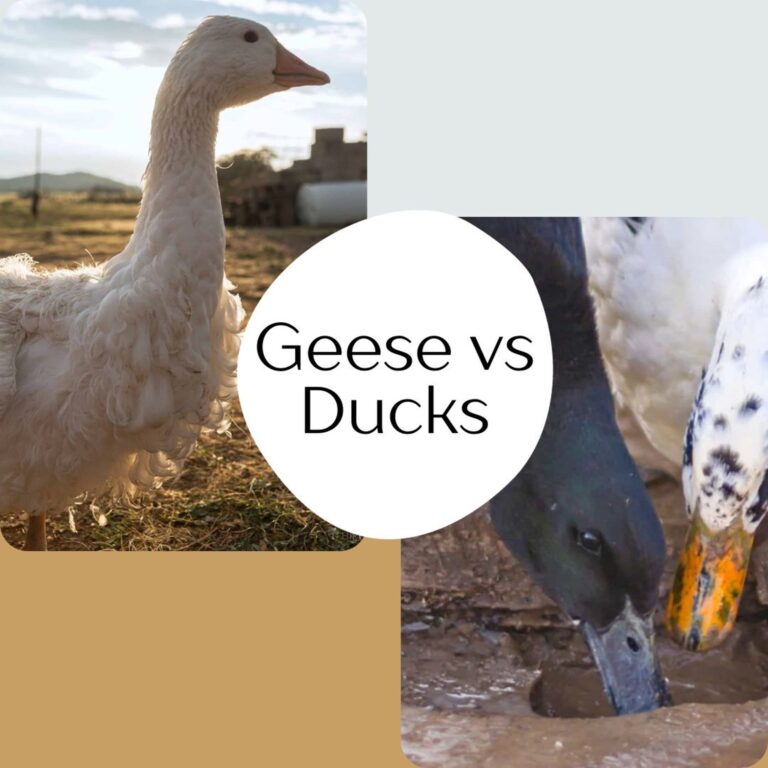
Of course, if you cannot decide and choose both, good for you, they do – for the most part – get along well. Let me talk to you about all the differences – and a few similarities – between ducks and geese.
Main Traits Compared
Let’s take a look at the main differences at a glance…
| Characteristic | Ducks | Geese |
|---|---|---|
| Family | Anatidae | Anatidae |
| Size | Smaller, generally 12-27 inches (30-68 cm) | Larger, between 20-45 inches (50-114 cm) |
| Body Shape | Compact, more squat | Larger and elongated |
| Neck Length | Shorter | Longer |
| Bill Shape | Wide, flat, and webbed | Stout and often hooked |
| Plumage | Varied, often colorful | Typically gray or brown |
| Vocalization | Quacking or softly honking | Loud honking |
| Migratory Behavior | Many species are migratory | Same |
| Habitat | Found in various aquatic habitats | Often seen in open fields and lakes |
| Social Behavior | Often seen in smaller groups | Tend to gather in larger flocks |
| Diet | Omnivorous, including aquatic plants and insects | Herbivorous, primarily grazing on grass |
| Lifespan | 2-20 years, depending on species | 10-25 years, depending on species |
| Reproduction | Lay eggs in nests near water | Lay eggs in nests near water |
Appearance
| Ducks | Geese | |
|---|---|---|
| Weight: | 4 pounds | 5 to 15 pounds, sometimes reach 20 pounds |
| Bill / Beak: | A duck’s bill is shaped like a spatula. Their beaks are long and flat. The bill has two parts, the shape is constructed of a bony skeleton. This structure serves as a jaw. The yellow or orange color of the beak is the result of a fleshy covering. It feels like the calcium of fingernails. The beak wears down naturally in nature. In captivity, or domestic birds, they cannot wear their beaks down. You will need to trim them occasionally. Ducks have, what look similar to teeth, but are actually lamellae, comb-like projections and grin patches that help the ducks filter their food. Their beaks are broader, longer, and flatter than gooses. The beak is made of keratin. | The beaks of geese are sharper than those of ducks. Their beaks are made of the same lamellae as the comb-like ‘teeth’ on ducks. They have what is called tomia, cartilage, on the inside of their bills. They do not chew their food. They grasp their food and rip it out of the ground. Their beaks are shorter than ducks’ bills. Their beaks are pink. Their beaks are also made of keratin. |
| Feet: | Webbed | Webbed |
| Plumage: | Their feathers are very waterproof. When they duck down, their outer feathers keep the feathers below (down feathers) completely dry. | Hatch with downy feathers, molt at 3 to 5 weeks old, get their adult feathers when they are 8 to 11 weeks old. An adult goose’s feathers weigh plus or minus 6.2% of the bird’s total weight. The tail feathers are a little dirty-looking with a gray spot that is surrounded by a white border. |
| Shape: | Ducks’ bodies are broad and elongated. The neck is long but not as long as gooses. Shape is different for different breeds. | Geese have muscular, large bodies. Their legs and necks are longer than those of a duck. |
| Diet: | Ducks are omnivores. | Geese are herbivores. |
Diet
There’s a vast difference between the diet of ducks and geese…
While ducks eat a mix of plants and insects, fish, worms, crayfish, snails, and amphibians, geese are strictly vegan?.
Geese stick to plant life from top to bottom (leaves, stems, and plants roots). Their beaks are designed to grab plants and rip the plants out of the ground.
A duck’s beak is designed to filter water essentially trapping food in their beaks.
Lifespan
A duck will live 5 to 10 years. If they are properly cared for, they can survive for 20, but this is a figure that only a few can reach, regardless of how well you care for them.
Geese live longer, for 10 to 20 years. As with ducks, there are those odd cases of birds that just keep going. The oldest goose known survived a whopping 40 years in captivity.
Internal Differences
Ducks and geese differ internally in the number of bones in their necks. Ducks have a maximum of 16 bones. Geese have 17 to 24 bones in their necks.
On the other hand, geese are significantly larger and heavier than ducks. They have a higher meat yield.
Sexual Dysmorphism
Many birds are dysmorphic, this means that there is a visual difference between males and females.
Ducks:
✓ Ducks are dysmorphic. The males are significantly brighter colored than the females. Males have a range of colors; females are very drably colored with mottled brown feathers.
The bright colors of males affect the likelihood of being picked to mate with as females are attracted to the most colorful males.
Geese:
✘ Geese are not dysmorphic. Their outward appearance is very similar.
The only differences between males and females are that males are larger than females and have differently shaped tail feathers.
A younger male goose can easily be mistaken for a female because females are smaller than males. Adult males are larger than females. Assuming the sex based on size can easily lead to errors as some males are small, young males are still growing, and some females are large.
Aside from their size, the only other outward difference is the shape of their tails’ feathers. A male goose has rounded tail feathers, whereas a female has pointed tail feathers.
Speed
Ducks fly 40 to 60 miles per hour.
Geese can fly an average of 40 miles per hour. If they have a good tail and wind, they can reach speeds of 70 miles per hour.
Behavior
Let’s compare ducks’ behavior with that of geese.
Ducks:
- Quack in a high-pitched tone when they are happy,
- Bob their heads when they are released into a pond or pool,
- Have close relationships with their families,
- Are very social,
- Have regional accents,
- Chirp when they see or hear you,
- Prefer to be in a large flock.
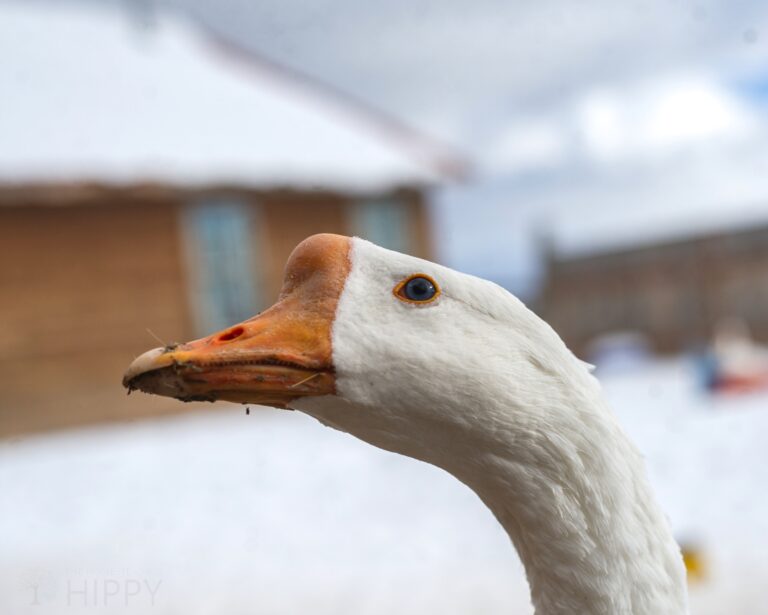
Geese:
- Geese are very loyal,
- They mate for life,
- Stay with their partners or chicks when they are ill,
- They mourn the death of their partners,
- Become depressed when they lose their eggs,
- They are very protective of their families and flock,
- Are territorial; this makes them great security guards for other animals they know and for people,
- Are good companion animals for just about any animal you have on your homestead,
- Are always collecting sticks, twigs, bark, and leaves to make their nests more comfortable,
- Can forge loving, affectionate relationships with people,
- Will follow you around if they are bonded to you,
- Are highly intelligent.
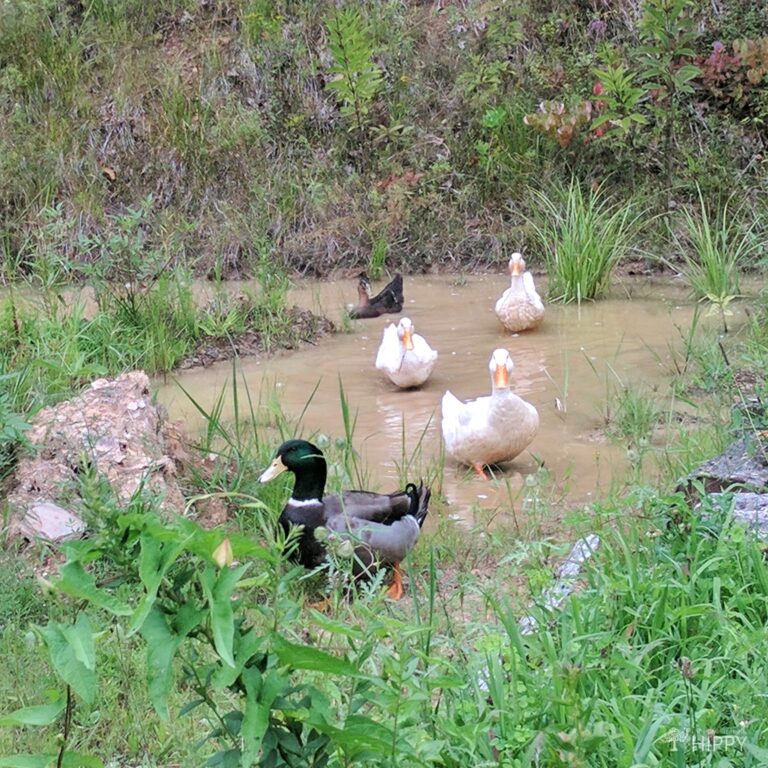
Breeding Habits
Ducks:
In North America, ducks breed between December and March.
Males are somewhat aggressive during copulation; therefore, the females’ reproductive systems have developed to protect the females.
Ducks are known for their girl power. The females get to choose their own partner, thus kicking their rejects to the curb in hopes they can entice another girl to pair with them. You go girls ?.
Hopeful males will have to prove themselves by becoming territorial and by displaying desirable behavior in the weeks or months before mating season.
Ducks will sit on clutches of 8 to 12 eggs at a time.
Ducks do not mate for life. Instead, they are monogamists only for one mating season.
Geese:
Geese have very strong family bonds. They mate for life but will eventually find a new partner if their partner dies.
Geese tend to find a partner to pair with when they are 2 to 3 years old. They mate once a year, between February and April in North America.
They lay 5 to 8 eggs a year that they incubate for 28 to 35 days.
When geese mate, they vocalize a lot and very loudly. The males do a dance of sorts by rolling their heads back and forth with their necks extended. They also raise their bodies and flap their wings to impress their partners.
To mate, pairs will wander off to be alone. Geese need water to mate, by the way.
Nests
Ducks:
Ducks prefer to make their nests in areas that are provided with natural cover, like bushes or in natural holes in trees. This gives them clever protection from predators by hiding in the vegetation.
Ducks lay an average of 12 to 15 eggs during their mating season. They prefer to build their nests close to water affording them access to food and an escape route if needed.
A female duck will create a shallow depression on the ground. She will collect natural vegetation by pulling it into the depression, she will line the nest and cover her eggs with down feathers that she plucks from herself.
Incubation takes about 28 days, and all her eggs will hatch together.
Ducklings are very dependent on their mothers and only become independent 50 to 60 days after hatching, until then they stay close to their mothers.
Nests are built in communal areas where they can be protected by all the members of the flock.
Geese:
Geese tend to build their nests in open areas where it is easy for them to spot approaching predators. They may build their nests against building walls or up against natural rock faces.
Nests are often built on a slightly elevated site and close to water. This affords the geese a better view to protect from predators, and an escape route to the water if needed.
The nests are made from dry grass, twigs, plant materials, and feathers from the female’s breast. The nests are cup-shaped.
Within 24 hours of hatching, the adults guide the goslings away from the nest. Geese only sleep on land during incubation or when they feel very safe.
Geese normally sleep on water where they can be safe from most predators. It is important for them to get the goslings away from the nest and into the water where they will be safe as quickly as possible.
If the nest has been destroyed by weather or natural forces, a goose will rebuild it in a different spot and lay new eggs. The exception to this would be if the goose has been incubating her eggs for more than two weeks, she will not lay eggs again in that breeding season.
The male is tasked with protecting the female in the nest throughout the incubation period. Once the ducklings have hatched, the male will protect the goslings and the female aggressively.
Imprinting
Imprinting means that a newly hatched bird immediately bonds to the first adult they see. However, they actually can bond with the first living being they see. That can mean a parent, dog, cat, or even a person they see.
Geese and ducks both imprint not only with adults but also with their siblings as the siblings generally see each other first. This ensures that they have a close sibling bond.
This helps them establish a relationship within the flock. However, that doesn’t mean they will follow each other. They will still imprint wholly on the first adult parent they see.
Imprinting is essential to the duckling or gosling’s survival as parents will protect their young and teach them important survival skills.
If they do not imprint, ducklings or goslings will not learn to find water or food for themselves and will not survive. If they do bond with another species, they will need your help to provide them with food and water, as well as a pool to swim in.
Once the offspring have been imprinted, they will stay imprinted for life. Imprinting changes their brain structure, meaning that it cannot be reversed.
Ducks:
It takes a duckling 12 to 36 hours but can take 14 days to fully imprint on their parent after they hatch.
Geese:
It takes 13 to 16 hours after hatching for a gosling to fully imprint.
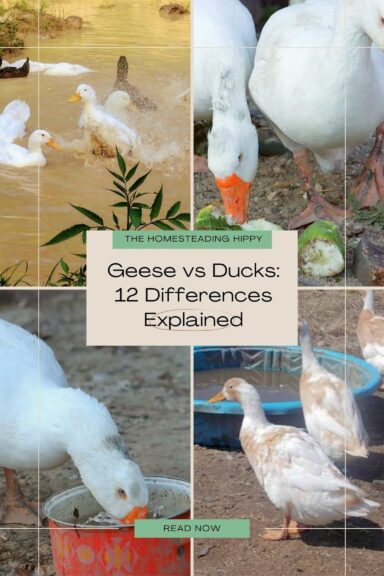
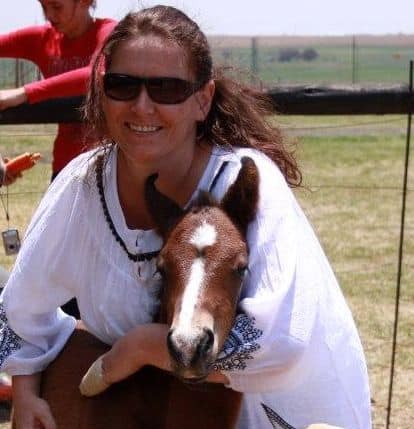
Di-Anne Devenish Seebregts was raised in an environment where daily life consisted of hiking, environmental conservation, growing fruit and vegetables, and raising poultry for meat and eggs.
She combined her passion for the writing word with her love of the pride that comes with not relying on others. She raised three children (who are now adults) to value the environment, and understand the value of being self-sufficient.
Find out more about Di-Anne on our About Us page.
